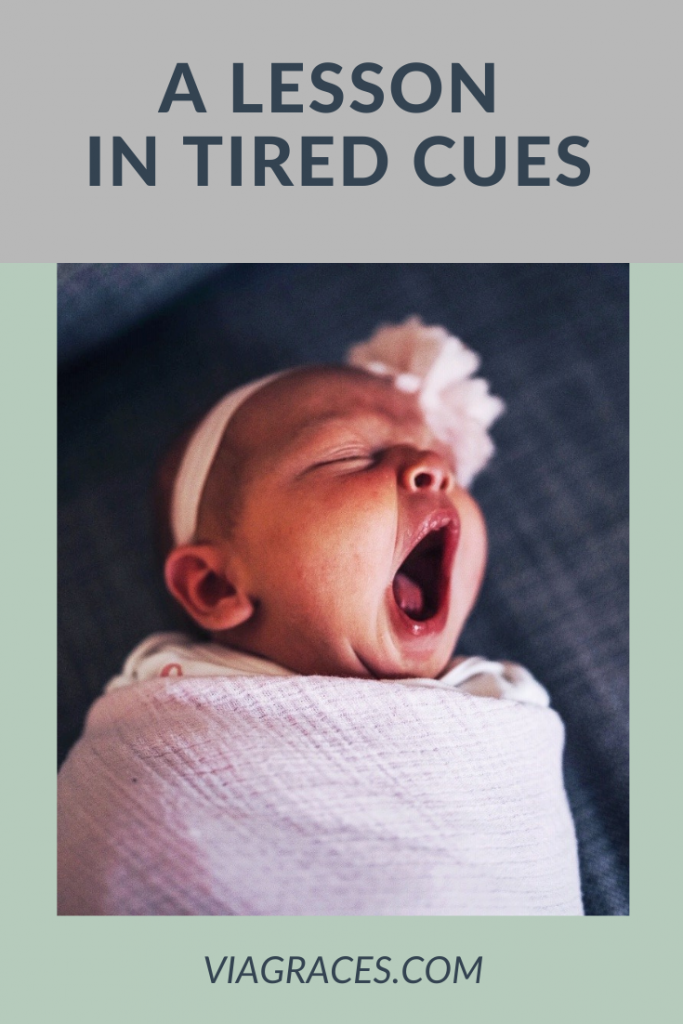“She just rubbed her eyes!” I remember having friends over when Olivia was 3ish months old, and my friend caught an eye rub that I didn’t see and she wanted to make sure I knew. RUN! She’s tired, avoid overtiredness, go lay her down, GOOOOO! I didn’t know much about sleep at the time, but I did know that tired cues were a thing, and I knew that overtiredness was a total bear.
Sometimes, those tired cues were spot on, we read them correctly, and sleep was (sort of) a breeze! Other times, we either missed the cues completely, caught them too early, or they didn’t exist at all (and/or we were all just humans that day!), and sleep was HARD!
So I want to walk through what tired cues are and how they can be helpful, as well as how tired cues shouldn’t be our one and only measure when it comes to baby sleep.

Some common cues that are helpful in indicating your baby is getting ready for sleep include:
- Staring off into space/lack of focus
- Yawning
- Rubbing eyes or pulling on ears
Some common cues that indicate your baby is overtired include:
- Rigidity
- Arching back
- Fussing/crying
The Problem with Tired Cues
The problem I often run into the with relying on these cues (both as a mama and sleep consultant) is that all too often, the cues come too early, they come too late, or they just don’t come at all.
Have you ever seen your baby yawn 30 minutes after waking from a nap, yet he wouldn’t normally nap again for another hour and a half?
Or maybe he rubbed his eyes, but you didn’t think it’d be time to nap again for another 45 minutes. What do you do with those cues? Lay him down anyway? Ignore them and risk overtiredness?
Or oppositely, have you ever been out and about, or with family, only to look at the clock and realize your baby should have been sleeping almost an hour ago but he is wide awake and totally content?! What does that mean??
This is where awake windows come into play and are crucial. When setting our babies up for sleep success, we want to avoid both undertiredness and overtiredness, and we do this by building up the right amount of “sleep pressure.”
If our kids aren’t tired enough, we will likely see a long protest that may or may not result in sleep, and/or a short nap. If our babies are too tired, we will likely see a long protest and possibly a short nap, night wakings, and/or an extra early start to the day. That sleep pressure needs to be “just right,” and understanding awake windows helps us get there.
Having trouble finding the right “schedule” for your little one? Go snag The Ultimate Guide to Sleep Schedules to help you!
But tired cues shouldn’t be totally written off.
Here are 4 scenarios in which tired cues are especially helpful:
- With newborns. While awake windows are still very helpful in newborn world, there will be some days or some naps your newborn can’t seem to hang for even 45-60 minutes…that’s okay, let that sleepy newborn sleep!
- When trying to determine your child’s awake window! Start with the “norm” for your baby’s age (i.e. 9 months = 3 hours awake), and then watch for tired cues as you navigate the windows.
- Your child is sick. When kids are sick, they aren’t always able to stay awake as long as usual. In that case, I tell parents to aim for the awake window, yet use tired cues to guide your decision in going for an earlier nap or bedtime. Trust your instincts!
- If your child caught a quick car nap or dozed off while feeding. I suggest you consider that little snooze somewhat of a “nap,” and aim to reset the awake window, however recognize that he might benefit from a slightly shorter awake window, so watch those cues.
So what about the second scenario above, when you’re trying to determine the right awake window. What if you get to the 3 hour mark and have yet to see any tired cues? STILL MOVE TOWARD SLEEP!
Some kids won’t show those tired cues until they’re beyond tired, or they simply won’t show them at all. (Yes, your child may very well need a bit more awake time than the average for his age, but we want to start more conservatively and go from there!) While tired cues can be helpful at times, awake windows almost always trump tired cues.
I don’t know about you, but for me, removing the need to observe every little tired cue took the pressure WAY off. Not to mention giving daycare or a caregiver instructions around your baby’s sleep according to awake windows rather than cues is so much easier!
It’s important to be observant of our kiddos, as they can communicate so much more to us than we give them credit for, however the clock is also a very helpful friend.
With Grace,
Lauren
